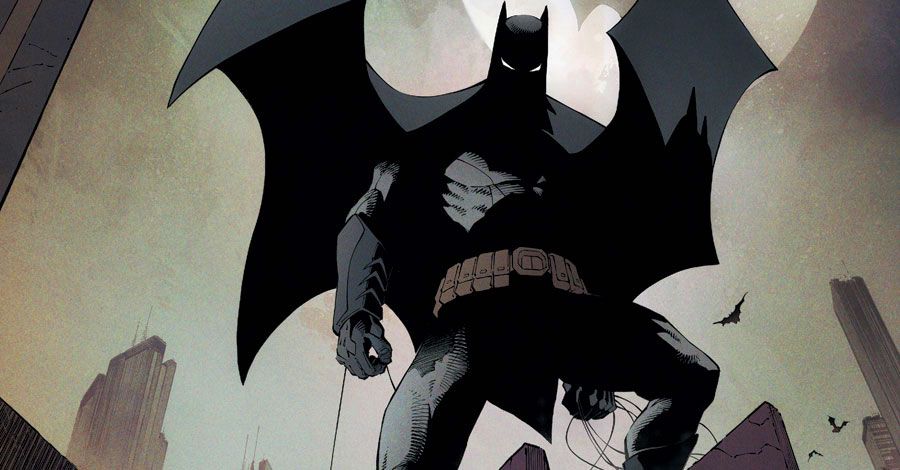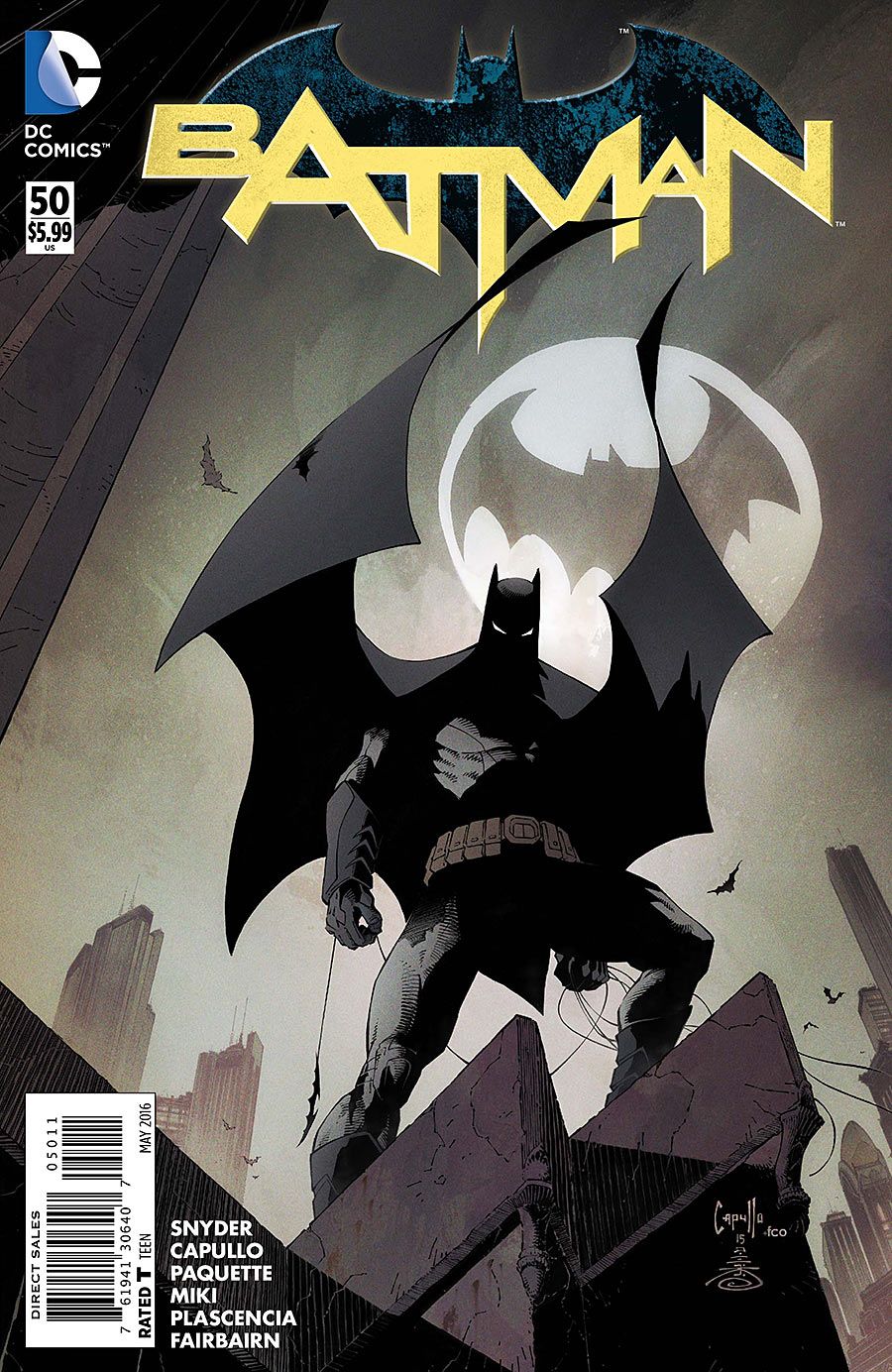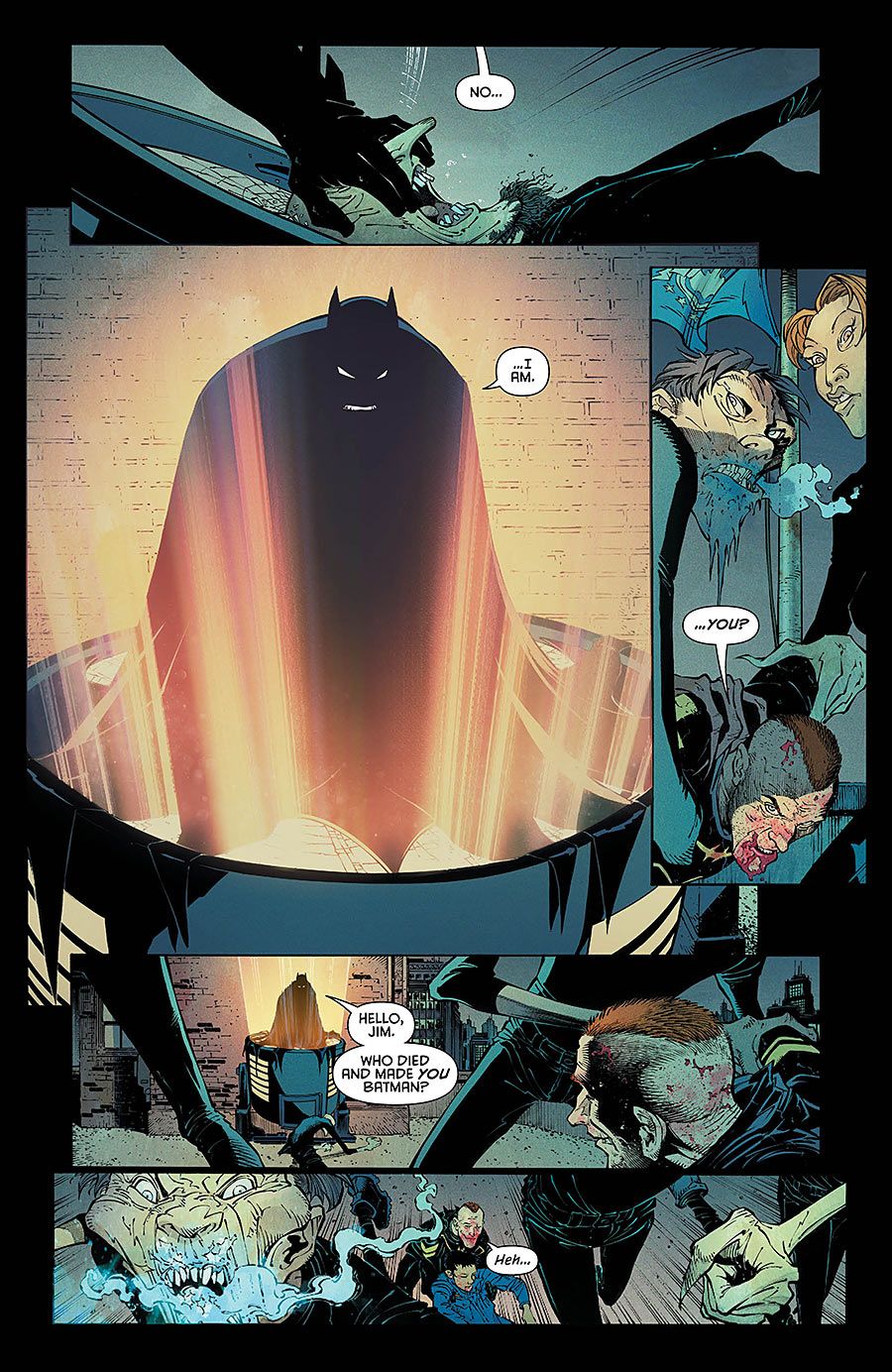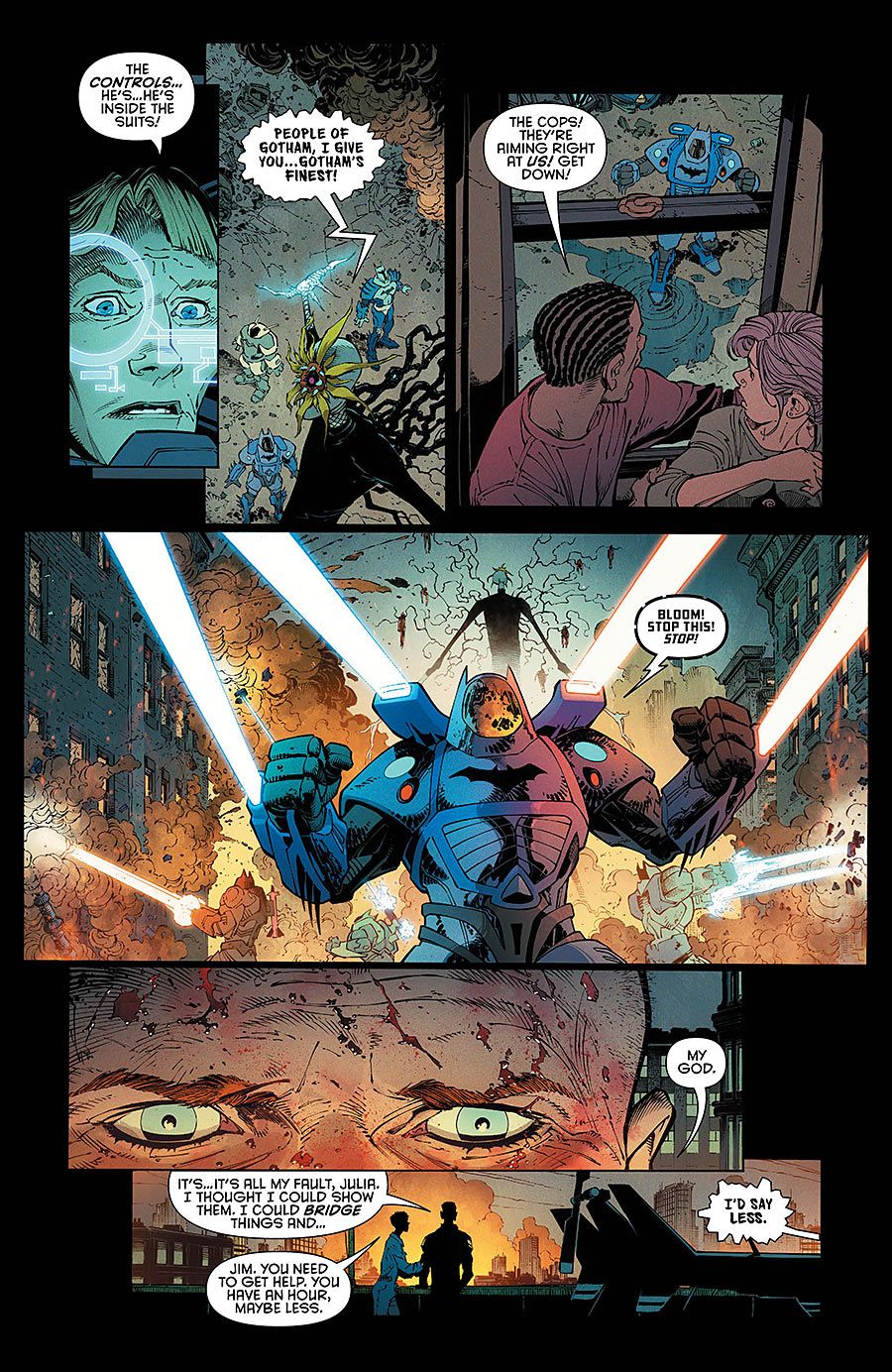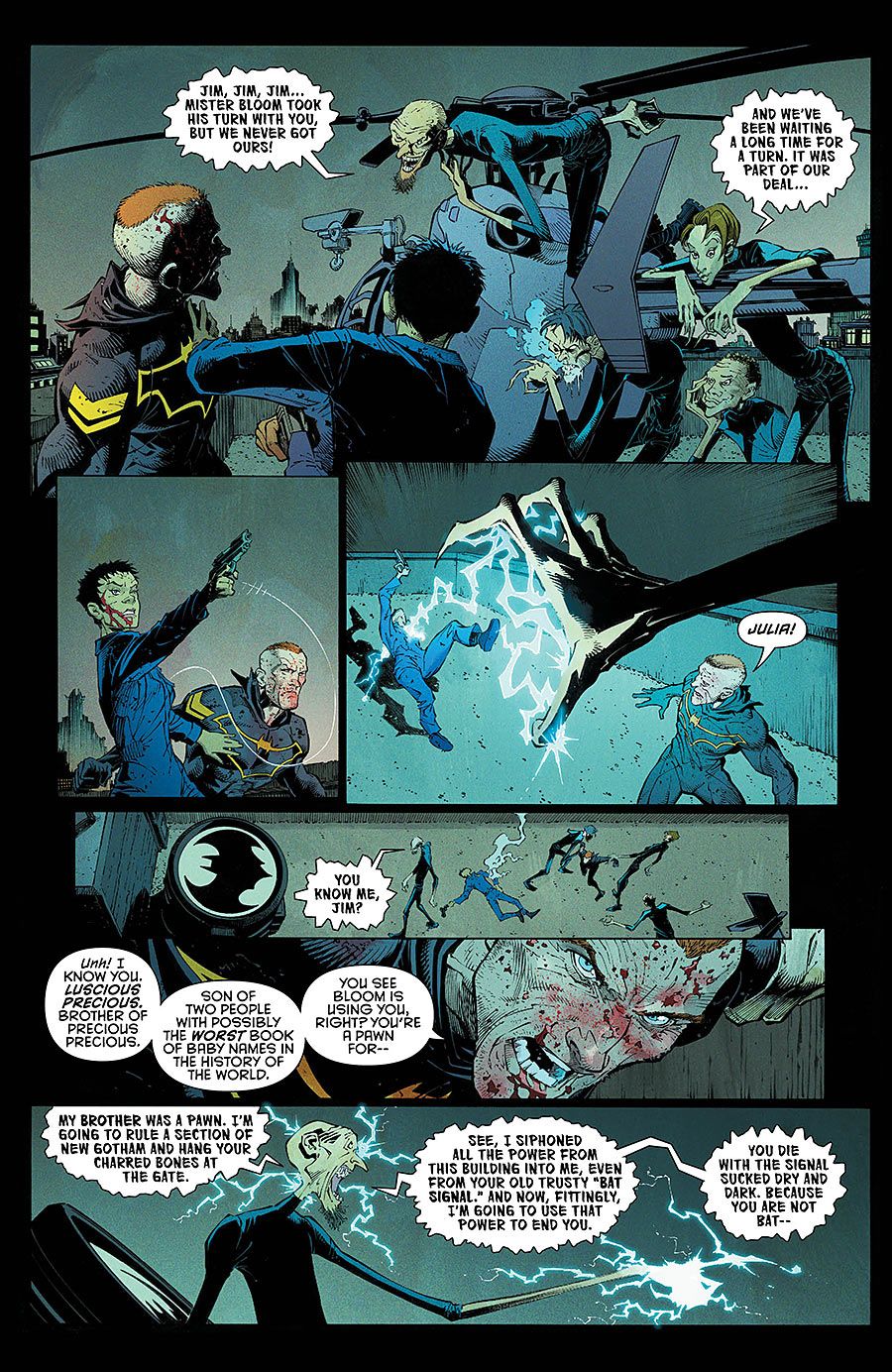SPOILER WARNING: This article contains major spoilers for "Batman" #50, on sale now.
While Scott Snyder and Greg Capullo have delivered a best-selling arc on "Batman" over the past eight issues without Bruce Wayne under the iconic cowl, it's been no secret that the day would come when the Dark Knight would return.
Today, in "Batman" #50, Bruce Wayne enjoys a boot-smashing rebirth in DC Comics' flagship series as the near-year long battle between James "Jim" Gordon and Mister Bloom comes to an explosive ending.
LOOK: "Batman" #50 Debuts the Dark Knight's New Costume
With just one issue left in their critically acclaimed run, CBR News connected with Snyder and Capullo to discuss the impact and importance of the "Superheavy" arc. The dynamic duo shared their thoughts on why the events that have unfolded in "Batman" since last summer have run in parallel with the ongoing U.S. Presidential Election campaign, despite the fact that such an analogy was never considered as the impetus for the story.
Snyder also revealed that he loved (and missed) writing Bruce Wayne as Batman, calling the original Caped Crusader's dialogue "hilariously and pathologically confident." Meanwhile, Capullo explains how putting Jim in a robotic Bat-suit was akin to working on a whole new series -- not that it wasn't lots of fun.
CBR News: After such an intense relationship that has led to one of the most critically acclaimed runs on Batman in the history of the character, is it weird that it's all coming to an end?
Greg Capullo: The relationship will remain, but yeah, sure -- it's weird. We've been playing in the same band for a long time, right? But as weird as it is, for me anyway, I think it's actually good because we're stepping off the book while we're still running hot and strong on it, which is always better than running it into the ground. [Laughs] It's always better leaving on a high note and leaving [the readers] wanting more. We'll take a little break and do some other stuff, which hopefully revitalizes some creative juices and refreshes the mind, so when we team up for the next project, we'll be geared up to start slamming it hard again.
Scott Snyder: Our friendship and our partnership is lifelong. Whether we are working together on "Batman," or we are working on something else or taking a break from each other has no effect on my feelings about Greg and my friendship with him. It's the truth that if it came down to trading our whole run on "Batman" and saying we never did it but we got to keep our friendship, I would keep our friendship. Greg is someone who has become a real big brother to me.
In terms of this being the end of the run, yeah, it feels weird, but I think this story was a great place for us to end. We still have "Batman" #51, but in terms of a big arc, it was probably the riskiest thing that we could have done. We tried, on this book, to be daring and do things that we were really passionate about, that were really personal to us in a lot of ways, and this arc was a culmination of that. We were trying to make something that was about what Batman means to the real world or what he can or should mean in our opinion.
We've talked throughout your run about the idea of life imitating art, and art somewhat eerily imitating life. With the presidential election in full swing in the United States, and Donald Trump's popularity continuing to rise, has his ascent been somewhat mirrored by what you have been doing with Mister Bloom in terms of what you might call fear-mongering and being fueled by the power of the people?
Snyder: It's funny, because we started the arc before the campaign really ramped up, so it wasn't particularly designed to be any sort of parallel to our current political climate. But I think the last few years, there have been a lot of things happening that highlight what we struggle with as a nation. Whether its race relations or class differences, it often ends up that we wind up blaming each other or stoking fear of each other rather than looking at these problems that can seem insurmountable and much more difficult to approach than to run away from them. So you're right, the arc was deeply about that.
For me, the story is about the fact that Batman fights giant, metaphorical things, these big, imaginary monsters like Bloom, which are just extensions of our fears of real-world things. It's not escapism. At its best, it's "Dark Knight Returns" or "Year One." It's about being brave and understanding that, like Batman, you can be a hero. He doesn't save you -- he comes back so you can save yourself. He inspires you to save yourself. It's a story that means a lot to me, and I am deeply proud of it. I'm glad that it came our right now, in that regard, because whatever your political beliefs are, whether you are Conservative or Liberal, I think one of the things that never works is vilifying each other, or blaming each other for things that we need to overcome together.
We have discussed at length why it was the right time for Jim Gordon to become Batman, but Greg, we'll start with you -- it must have been fun to draw Bruce Wayne again, smashing his brand new boots into a villain's chest.
Capullo: Yeah, of course I missed Bruce under the cowl as much as anyone else. I am very happy we did what we did with Gordon, but I wanted big, beefy Bruce back in action! [Laughs] He's bigger, faster and stronger than ever. I'll tell you, it was weird shaving the beard off. When I drew him the way I have always drawn him, I thought he looked so baby-faced. I'm glad he's back, but it felt awkward drawing him the first time without a beard. It felt very strange.
Snyder: There is image Greg drew for "Batman" #51 of Bruce getting ready, and he's in under armor, looking fit. And it's like, if only we could do that! If only we could be healed and go back to looking like we did five years ago. [Laughs] Get rid of the greying hair and everything.
Capullo: It's a lot like the President [Obama]. He came in all shiny and new, and he's leaving looking like hell. [Laughs]
Snyder: Look at the progression. When I started writing Batman, he was Dick Grayson. He was young and new. We ended on Gordon, and he's old and broken-down. But then you renew him. That's comics.
Scott, did you have any trouble finding Bruce's voice as Batman after eight issues of "Superheavy?"
Snyder: No. [Laughs]
It was really fun. Honestly, I missed it. It was harder to write him the other way. That was a construction that was ours, and it was brand new, this idea of Bruce living with the trauma of his life removed. I have been itching to write him this way again for a long time. I enjoy writing his dialogue so much, because he is hilariously and pathologically confident. I missed that. When you come back to it, all these one-liners pop into my head. [Laughs] I could write his dialogue forever.
Jim tries to apologize to Batman a few times in this issue for trying to replace him, but Batman doesn't allow it. That speaks as much to Jim Gordon as it does to Bruce Wayne. Having written Jim as Batman for this arc, do you now have a better understanding and appreciation for the long-time supporting character?
Snyder: Yes, completely. Jim Gordon is absolutely one of my favorite characters to write. This arc was about Jim wanting to make Batman something in the real world. He wanted to pull him out of the imaginary world that he exists and have him be something that can heal wounds in the world that Jim functions in, which is the world of police and crime and local government. And he realizes that it just can't be. Batman can not be real in our world. There is something deeply heroic and noble and sad and tragic in all of that. I know that he did the wrong thing but I also know that his intentions and his heart were completely pure. I had a great time writing him in this role and have a far deeper affection for him afterwards.
And Greg, my guess is that when you signed up for "Batman," you didn't think you would end up drawing Jim Gordon running around in a robo-charged Bat-suit.
Capullo: [Laughs] No, it was like starting a new book but not starting a new book. And you're right, I never thought I would be drawing this stuff. It's been like drawing a Batman book that's not a Batman book. It was very different yet it felt familiar by the way Scott casted everything. The circle of friends all fit together comfortably. It took me a while to get the hang of drawing the Rookie suit in a million different angles but once I did, it was all fun. But I am happy to be back with Bruce too, even for a few issues.
Finally, there is a great panel at the end of the issue where Batman shares the differences between The Joker and Mister Bloom: "The Joker... the darkness in him... no one could be him. But Bloom, ANYONE can become Bloom if they lose hope in this place." That makes Bloom pretty scary!
Snyder: Like I said, for me, Batman is an impossibility in the real world. He always wins and he has all of these skills. He is the pinnacle of human achievement, which is impossible to reach. But Batman inspires us because he is a superhero. The Joker, to me, is the reverse of that. He is so evil and so dark that no person could really become that thing. He is essentially the Devil.
That makes Joker and Batman these huge mythological figures, whereas the scary thing about Bloom, like you said, is that anyone left alone with their hopeless thoughts and their feelings of frustration and anger -- whether it's a personal ideology or work or life -- can become the kind of monster Bloom is. They are almost inversions of each other. No one's life could warrant the creation of something like The Joker, but anyone can believe the things that Bloom says and does. And that's scary.
"Batman" #50 by Scott Snyder and Greg Capullo is available now.

